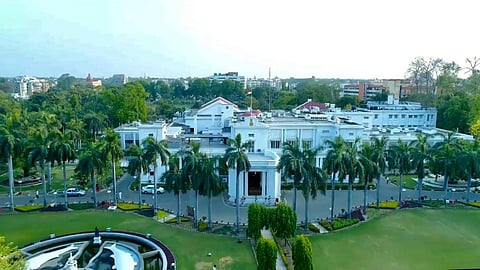Did you know that Raj Bhavan of Lucknow was once known as Kothi Hayat Baksh?
Built by the exemplar Nawab Saadat Ali Khan and designed by the genius of Major General Claude Martin, Kothi Hayat Baksh stands today as the historical and architectural marvel known as Raj Bhavan of Lucknow.
Kothis built at the time of Nawabs, under the confluence of East India Company, varied from the archetypal Indian architecture. They typically showcased two storeys, lawns, plain walls, hints of Goth in their designs, and points alike. And no different was Kothi Hayat Baksh (literally meaning a house that gives life) that still flaunts stark European architecture built as a two-storeyed building, enveloped by a rich green cover and spacious lawns.
Taking you on a historical dive into the rich roots of the history of the city of Nawabs, we're here to dispense all about this prodigal wonder.
A magnificent work of art
Major General Claude Martin, the mastermind architect behind La Martiniere College in Lucknow, had taken a particular liking to the culture and traditions that city of Nawabs engulfs. Soon, he had chosen the city as his permanent abode and went on to becoming a chief in Nawab Asaf-ud-Daulla's darbar. The emperor's successor Nawab Saadat Ali Khan was peculiarly fond of the European-style buildings constructed by Martin.
"The Kothi Hayat Baksh is one such work of art created in partnership by both of them," recorded a UP government site.
A palatial and airy site, the building was constructed sometime in the late 1790s, in the arms of high roofed verandahs. Some part of the kothi, like the Raj Darbar, is famously made on the lines of Indian architecture, while the rest of it flaunts a European aura. The deewan khana inside has floral arches amidst a splash of royal golden colour. The green and golden walls and roof with magnificent chandeliers only augment the beauty of this palace.
From the historical memoirs
The palace also has a connection to the Indian Mutiny of 1857, when it was frequented by Sir Henry Lawrence during the rebellion.
After that it became a part of the cantonment area when occupied by Colonel English and thereafter Chief Commissioner of Avadh Major Johnshore Bank. At the time, the kothi came to be known as 'Bank Kothi', and its adjacent road 'Bank Road'. Major Hudson also breathed his last in Kothi Hayat Baksh. Subsequently, the kothi became the headquarters for the British army. The Indian freedom fighters would often attack the colonialists residing here and it was, more often than not, protected.
Transition to Raj Bhavan
As the colonial era came to an end, even before Indian independence, the kothi became home to Indian governors, and thus, came to be called as Governor House. "It was declared as the official residence for the Governor of United Province Agra and Avadh. During that time the Raj Bhavan was given its final present shape," the record says.
After Independence, the building was renamed as Raj Bhavan. Numerous changes were made to beautify the palace further during the different governors' era.
Today standing as Lucknow's preeminent Raj Bhavan, its grandeur has been conserved. Statues of rivers Ganga, Jamuna and Saraswati and a pair of leaping fish adorn its entrance. A marble umbrella embellishes the lavish garden here and, doubt you not, just like that, the charm of Kothi Hayat Baksh stays alive.
To get all the latest content, download our mobile application. Available for both iOS & Android devices.

